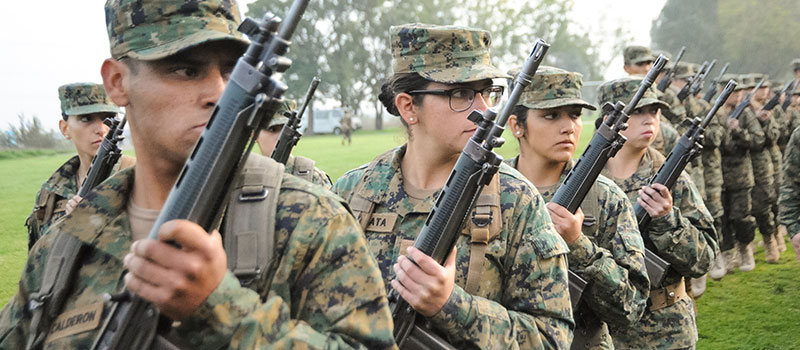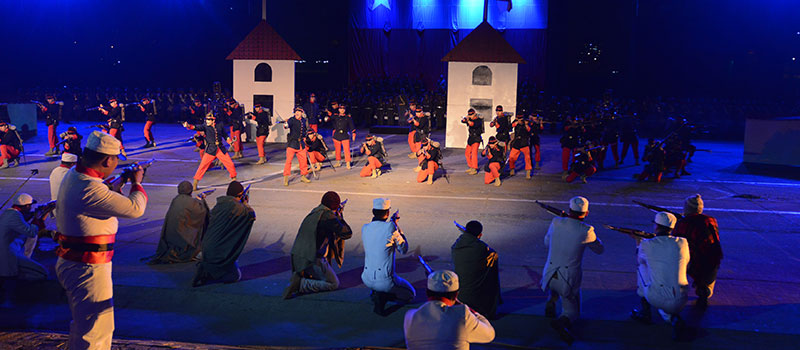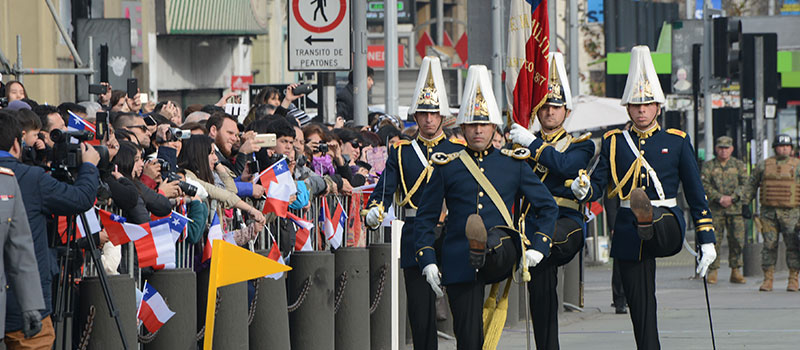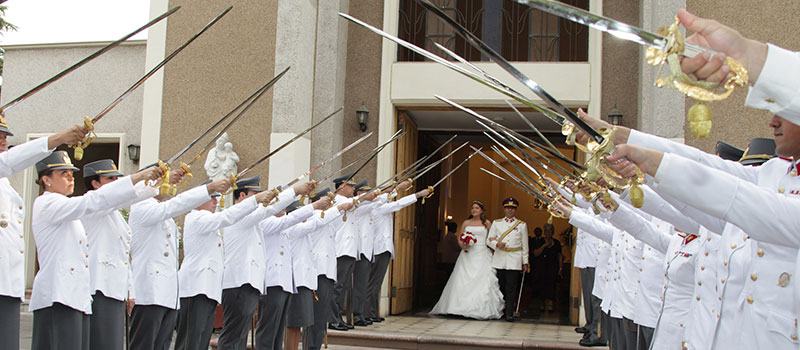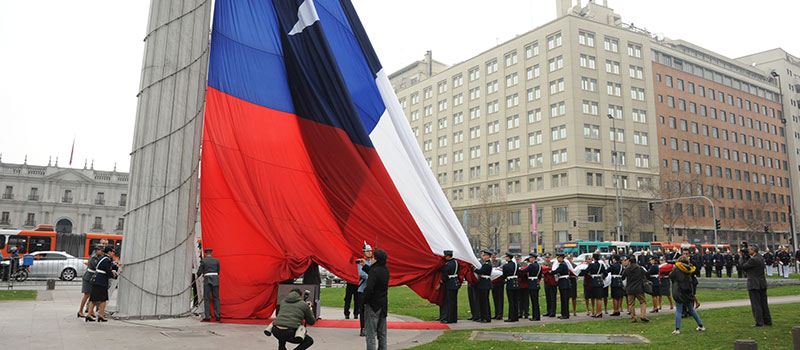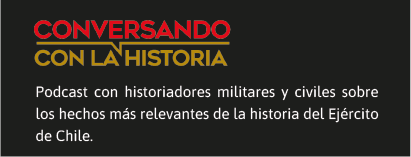213 years of history
CEREMONIES AND TRADITIONS

Military Parade
Each year on September 19, a commemoration parade is held in honor of “The Glories of the Chilean Army” (Día de las Glorias del Ejército) at Parque O’ Higgins Park, in Santiago de Chile. At this solemn event, selected groups of soldiers parade in representation of the Army. Additionally, the Navy and Air Force -institutions part of the Armed Forces-, the Chilean law-enforcement agency Carabineros de Chile, the Criminal Investigations Police (PDI), foreign delegations, and the traditional folklore group Club de Huasos “Gil Letelier” also take part in this tribute.
After the presentation of officer training academies, institutions march in the following order: Chilean Navy, Chilean Air Force, Carabineros de Chile, and finally, the Chilean Army which closes the Military Parade. The country’s highest authorities preside over led by the President of the Republic, who is in charge of granting permission to the “Head of Ceremony Presentations” to begin the parade.
The national significance and symbolism that revolves around the Military Parade recalls those fallen defending Chile’s honor and arms, not only in the liberation process of the country but during subsequent conflicts, such as the War against the Peru-Bolivian Confederation and the War of the Pacific.
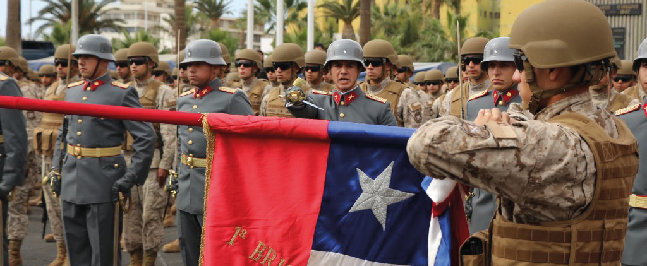
Pledge of Allegiance
In this ceremony, Chilean soldiers assert and express their loyalty and dedication to serve the country, having God and the Flag as witnesses. Unlike a simple promise, an oath is sacred. It stands God as witness of the firm commitment of soldiers, who are willing to give their lives for the honor of the country, and to protect national heritage.
Soldiers freely express the commitment they’re acquiring, and their fellow citizens will be the ones who will seek the compliance of it. This Pledge of Allegiance is also a legal duty. It involves the compliance of the service oath, pursuant to the provisions set in the “Armed Forces Organic Law” Art.1 Law 18.948.
Symbols and values related to God, loyalty and the fulfillment of military duty converge at this ceremony. Three distinctive elements are present: the Soldier, the Flag and the Country. This event concurs with the annual commemoration of the battle of “La Concepción”, which took place a in the Peruvian highlands during the War of the Pacific. Chilean troops cantoned in the Peruvian town “Concepción” perished entirely under the command of 1st Lieutenant Luis Cruz Martínez, who before his death shouted at the enemy: “Chileans never surrender.”
Weapons handover ceremony
All units, academies and schools that enlist conscript soldiers conduct a ceremony where they receive a weapon to defend the country. In this instance, family (parents, siblings or representatives) represent the Nation; it is the symbol for the country’s driving forces. In that sense, three figures come together: God, who gives soldiers their soul; parents, who make their physical existence possible; and the State, which provides soldiers with weapons and puts trust in them so that they can use these for the sake of national interests.
This ceremony strengthens the mission that is given to the Army through the Political Constitution of the Republic -in the sense of having the legal monopoly of the rational use of force. Through it, the Army is enabled to complete defense and security missions of national sovereignty, protect people, and defend the territory against threats to national community.
Grand "Retreat" (musical event)
Once a year, troops gather in order to have a moment of spiritual reflection during the final period of combat training and at the end of concentrations and/or exercises in divisions, brigades, or academies and schools. This ceremony evokes the most memorable military traditions and gives special recognition to the Chilean soldier, recalling national historical events and including an analysis of the feelings and sensations experienced by soldiers on field.
Promotion Ceremony
The merit and professional career of the personnel promoted are recognized in this especial event. The ceremony must be conducted in the presence of the entire unit, in order to present the newly promoted and the new rank, which entails a new hierarchy with different duties and obligations that he/she is expected to fulfill. Ideally, ceremonies are held close to the date of the promotion decree. Direct family relatives are invited to attend the event, where the unit’s commander or director will put the new ranks on the soldier promoted.
A special reception is held at an informal level, typical of Chilean military camaraderie. The unit’s ranking officer will briefly take the floor to explain the purpose of the reunion and then, the ranking officer/NCO of the rank from which the soldier has been promoted offers his/her best wishes. Finally, the lowest-ranking officer/NCO of the rank to which the soldier is being promoted extends him/her some welcoming words.
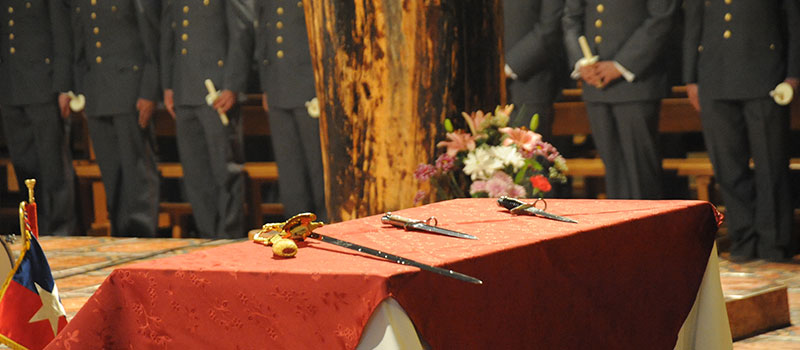
Vigil of Arms
It’s a traditional rite that is celebrated the night before the “Pledge of Allegiance”. Those who are about to pledge reflect on the future duties to the country and the challenges that lie ahead in their military career. The “Vigil of Arms” is that necessary moment of reflection for those who will take the responsibility of “taking up” the weapons given by the country to defend it, "until giving up life if necessary."
It is based on military life events from the Middle Ages. Since 1900, it has been done in all Army units on a date which coincides with the entry into force of the conscription law -or Mandatory Military Service. During the ceremony, the religious freedom of the soldiers must be respected at all times, so that the prayer is taken equally by the group without distinction of any kind.
Honoring the Combat Standard
Whenever it is necessary to exhibit or stow the unit’s Combat Standard in a formation, honors are rendered by the entire unit singing the National Anthem. This tradition has the purpose of promoting increased respect and affection for this national symbol.
The standard and its escorts form up at the front of the unit, and the ranking officer/NCO must give the order to render honors. During this activity, the standard-bearer officer and escorts goose-step in front of the entire unit, both back and forth, to then take position at the front of the unit.
Sabers Arch (or Swords Arch)
It’s a military tradition performed at the weddings of active military service officers. As a way of showing their affection, comrades of the newly-wedded officer form an arch with sabers or swords just outside the church.
The sword is the officers’ symbol, par excellence. Therefore, officers receive an exact replica of the sword of the founding father, General Bernardo O’higgins Riquelme.
In the case of NCOs’ weddings, the NCO’s comrades form a line, similar to that of the officers, and honor the newly-weds performing the military salute with a hand on the rim of the visor. For this reason, this ceremony is also called “rendering honor in wedding ceremonies."
National flag raising and public squares parades
On Sundays, the national flag is hoisted at town’s Main Squares (Plaza de Armas). This tradition goes back to the early years of Independence. The current flag was publicly raised for the first time on February 12, 1818, during the solemn proclamation of Independence, in which as well was established the Pledge of Allegiance.
The main city squares of the country have traditionally been a family meeting place, where citizens usually walk, meet and celebrate festivities. Therefore, having a small military unit raising the national colors, together with an instrumental band, is an opportunity to maintain contact with the community. Once finished, the formation unit leaves and the band offers a musical show in the same location -or where the public can gather together- and play popular, folk songs and a selection of military marches.
